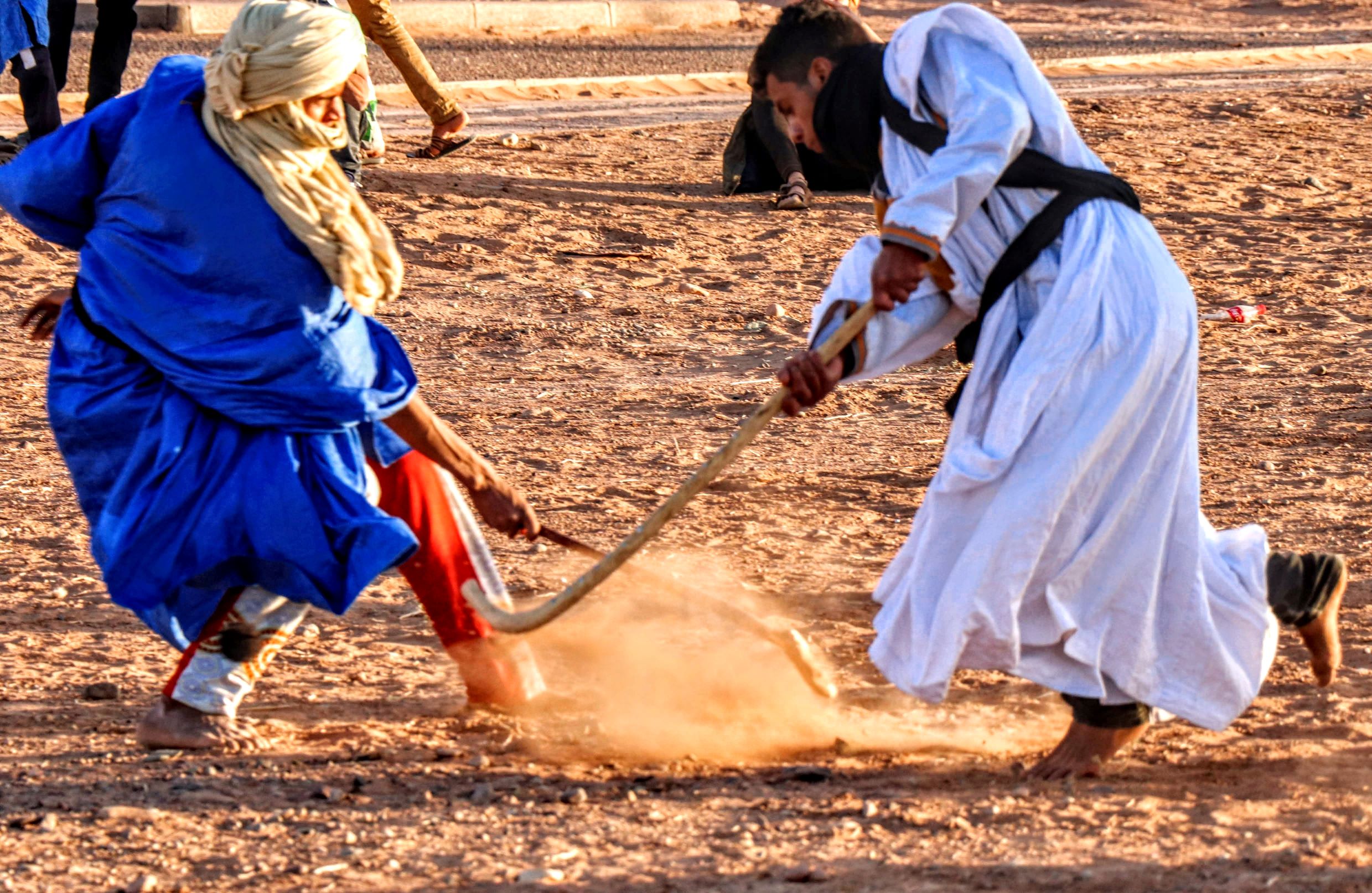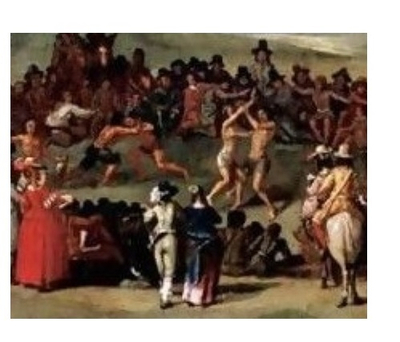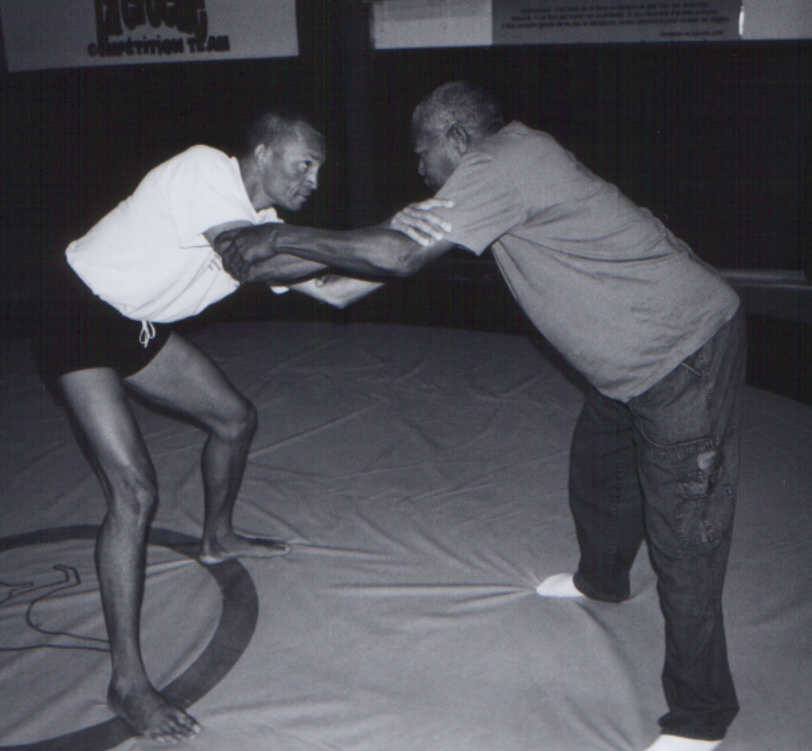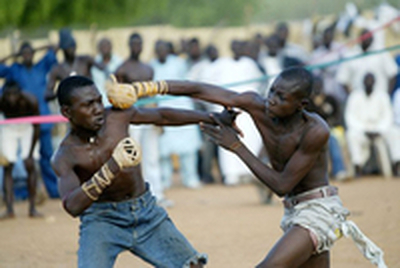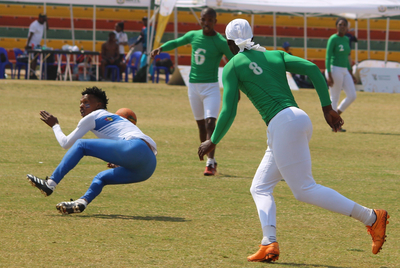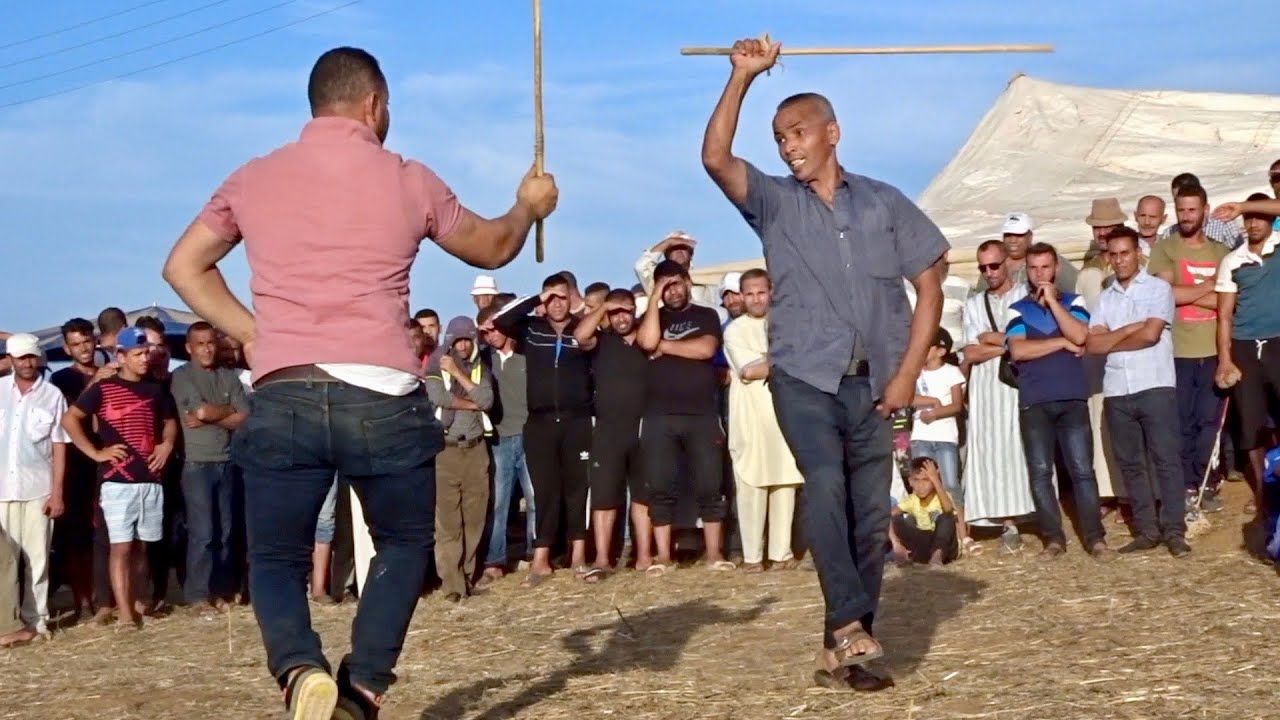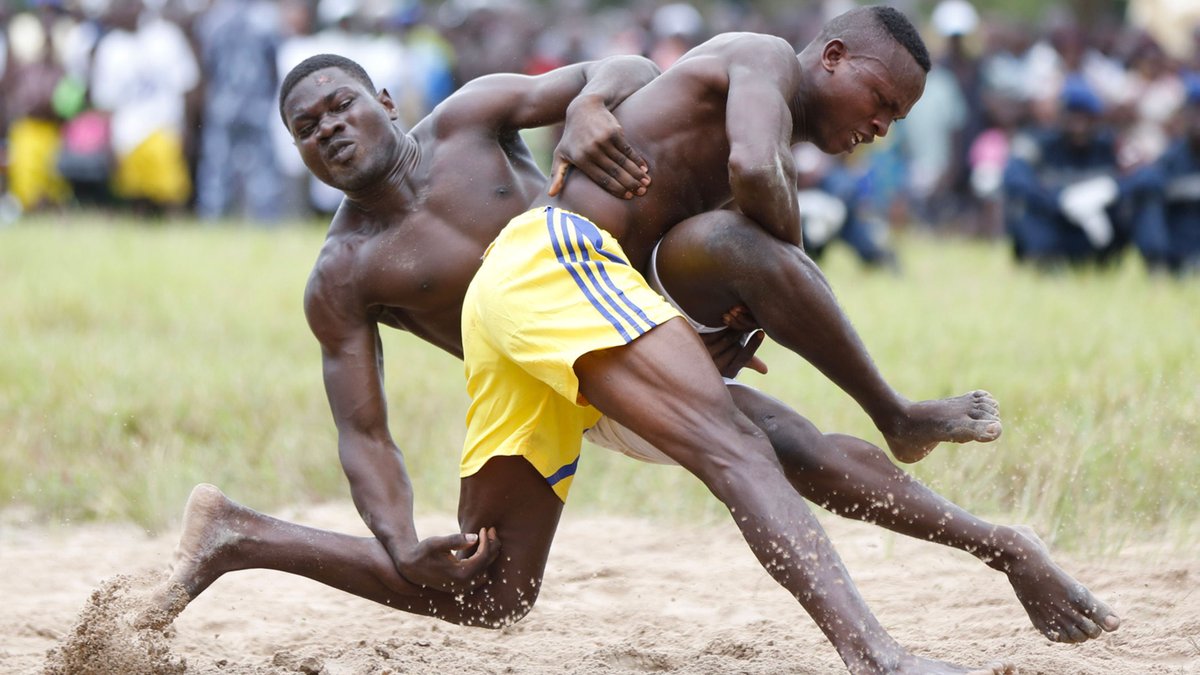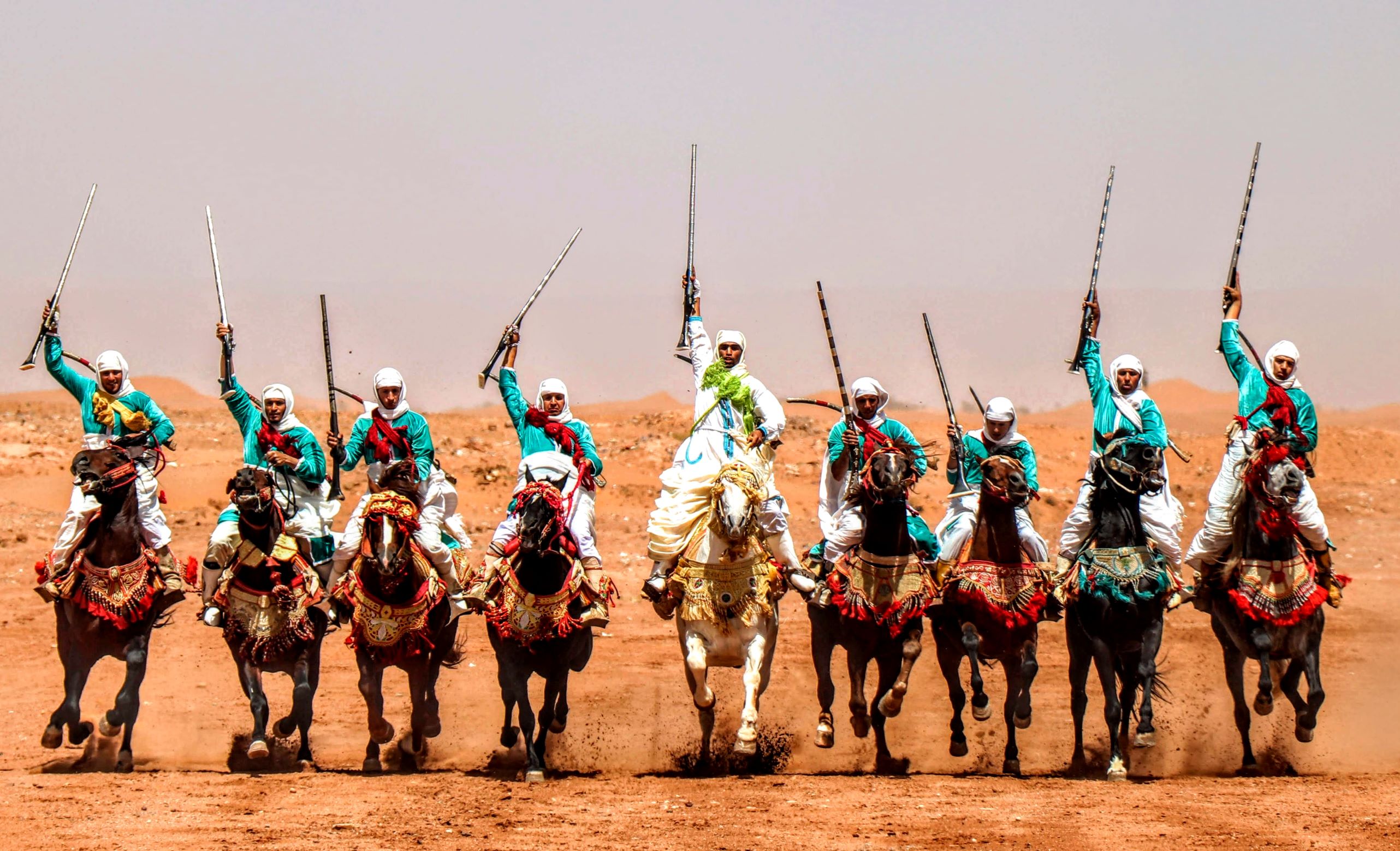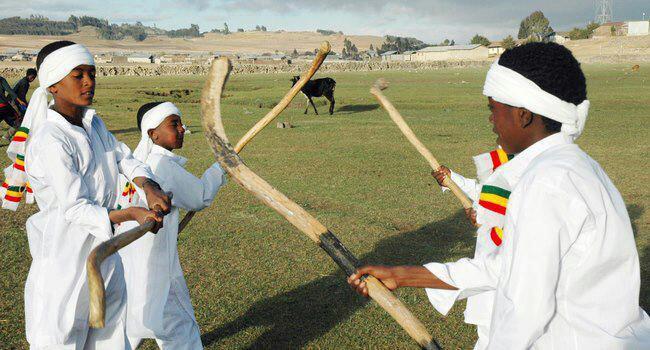- Name of sport (game): Akseltag, Hockey saharien, Hockey des Touareg, El Mekchah, Hockey nomade, Hockey des Bédouins
- Name in native language: Akseltag, El Mekchah
- Place of practice (continent, state, nation):
Morroco, M'Hamid El Ghizlane
- History:
The popularity of this game comes from the history of the nomads of Eastern Moroccan
Sahara. - Description:
The players use bats, not industrial, but made from tree branches, the ball is in the coat of dromedaries.
This collective game pits two teams, each composed of seven players. Seven players in Sahrawi dress, barefoot, and seven others in white dress are standing while waiting for the signal of the start of the Sand Hockey match, by the referee. There is a rule of play monitored by the referee commonly known as “Sheikh”. The goal of the game is to score points each time a team manages to push the ball behind the opposing team’s lines.
The playing time is not defined in advance since the two teams agree on its duration before the start of the game followed by ordinary citizens or by dignitaries of the region riding dromedaries.
All games end with collective festivities highlighting the sporting fair play associated with the Saharawi footprint, and seemingly reminding that the essential is the joy of entertaining and promoting support for this game. - Current status:
This popular game is played by nomadic tribes in the M'Hamid El Ghizlane area. Players in the region are doing their best to revive this game that fights oblivion like other popular games across the country.
- Sources of information :
Article:
https://www.aa.com.tr/fr/sport/maroc-le-hockey-du-d%C3%A9sert-lutte-contre-l-oubli/798819?fbclid=IwAR05I5ISt83WjYZbTYrLQ6M6xFzgdBbz5LlLXqQCvZcrxnX63XqYJcSUxhU
https://www.aa.com.tr/fr/pg/galerie-de-photos/maroc-le-hockey-du-d%C3%A9sert-lutte-contre-l-oubli - Gallery:
- Name of sport (game): Bassula
- Place of practice (continent, state, nation):
This art was practiced in the community of Axiluanda, by the Axiluandas and Bessangans in the Luandan coast, the greatest practitioners could be found among fishermen.
- History:
Bassula is one of the traditional martial arts of Angola, the term Bassula means swiping, making the opponent to fall. One of the last masters was António Joaquim (Cabetula), who was born on August 20, 1920 in Ilha do Cabo in Luanda and died at age 84 in Mussenda (Boavista), a place that no longer exists.
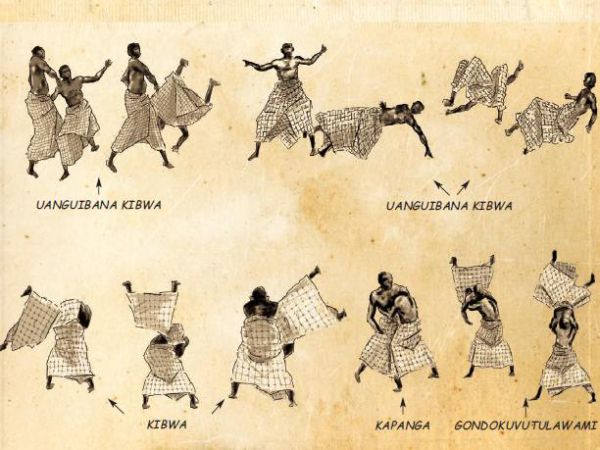
The Bassula of Jinvunda was violent and the contenders had to demonstrate their techniques and abilities, sometimes using artefacts such as staves (barrel boards) and razors.
The Samba Grande fishermen practiced Bassula, from the Ilha do Cabo and Samba Pequena, who were, basically, people of the same lineage origin, this was to strengthen friendship and brotherhood.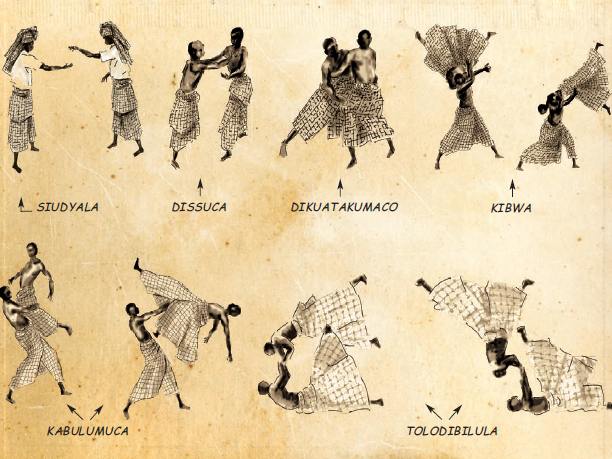
- Name of sport (game): Boers Folk Wrestling Styles (South Africa)
- Place of practice (continent, state, nation):
South Africa
- History:
The Boers or Afrikaners are South African people of Dutch, Flemish, German and French (Huguenot) descent.
Usually the Boers folk wrestling matches along with other rustic sports (the Boeresport) like climbing the slippery pole, foot racing, sack race, leaping, three-legged race, running with an egg in the spoon, tug of war, arm wrestling, archery, spit sheep manure, stick fighting and etc. were played on the annually held festival called the Farmers’ Day (the Boeredag). The games/festival would start with an opening prayer and reading of the Scriptures. It was a day of joy and the main festive gathering of the Afrikaner people of the area.
The 1902 newspaper article thus spoke of the Boers wrestling: “Amongst the young Boers wrestling is exceedingly popular. The champion wrestler of a district is as much thought of as is his confrere in the North of England. Such a man can always have the pick of the prettiest girls in the district for a wife.”
In his memoirs Boer military commander General Ben Bouwer (1875-1938) mentioned the popularity of wrestling pastime among the Boer officers. He gives an account of his success in a wrestling match against a local strongman and wrestling champion General Manie Maritz (1876-1940). A horse was at stake in that contest. The famous South African pro wrestling champion Manie Maritz (1925-2018) was the son of that military of the same name.
Wrestling customs of the Boers were of Dutch/Flemish origin. By the beginning of the XX century traditional folk wrestling styles were long forgotten in the Netherlands and Flanders, but they were still actively practiced by the Boers in the XVIII and XIX centuries. It appears that historically an organized pro wrestling wasn’t as common in the Netherlands and Flanders as let’s say it was in England.
Different kinds of wrestling games which were popular among the local farmers (boers), along with cudgels, were played during various folk and religious festivals such as Kermis van Sint Joris/Kermis of St. George (Patron of Military and Martial Arts).

- Description:
The wrestling styles (worstelen, wrestling or werpen/gooien throwing) of Dutch and Flemish people existed in two distinctive modes, the standing wrestling for a throw (neergooien, smijten, smakken throwing someone down, giving a fall; or ondergooien throwing someone down on his back, giving a back fall) and the up and down wrestling for taking someone down and overcoming him on the ground/keeping him underneath, also Dutch Onderwerpen to subject, to submit, to bring/put under, same as German Unterwerfen to subdue, to submit or Unterwerfung submission, pinning fall).Those two modes corresponded to the “Half” (Halber) and “Full” (Ganzer) modes of German folk wrestling the Ringen respectively.
Among the wrestling techniques used by the Dutch/Flemish farmers were aanklampen (catching holds) and vasthaken (hooking legs). Both of those wrestling skills are shown on a XVII century painting by unknown Flemish artist called “An elegant crowd watching men wrestling in a landscape.” On this painting the wrestlers are shown barefoot and their only attire is either a drawers or a loincloth. Notably, the portrayed on this painting catch-hold of one of the two pairs of wrestlers is a typical pro wrestling opening hold when wrestlers grab by the back of the necks and elbows. Plukharen (grasping hair) as well as any other non-wrestling or deliberately brutal acts were strictly prohibited during the wrestling contests.
Before the match the two boers negotiated the wrestling conditions of the match, whether it’ll be Lyfvat Neergooien/Ondergooien or Stoeijen.
Lyfvat (Lijfvat, Lijfvatten) was an equal above and under grip around the torso/waist (German Bauern-Griff, Peasants Grip). Originally it was a fixed hold archaic trial of strength. The objective of the original Lyfvat match was to unbalance the opponent without using any wrestling techniques and take him down (Neergooien). In that game the physical strength was a decisive factor.
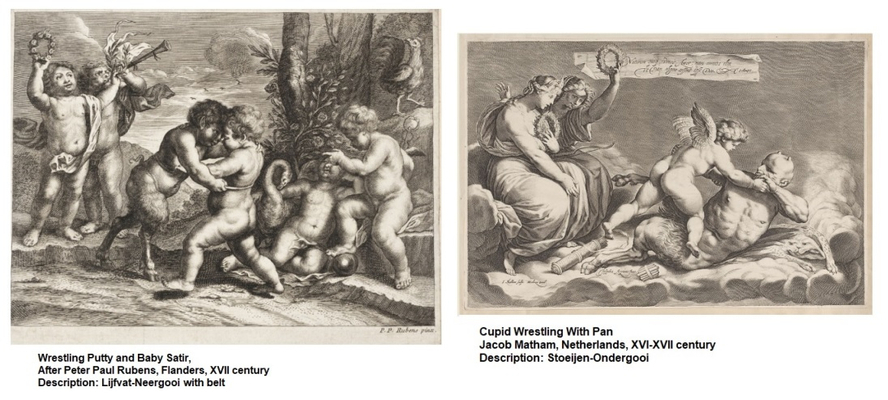
Over the time this trial of strength evolved into a new wrestling style Lyfvat Neergooien/Ondergooien. In the Late Middle Ages the Lyfvat Hug became a common opening clinch hold in wrestling matches. To make such hold more firm often the wrestlers were wearing belts, in this case it was “one hand to the belt” and with the free hand wrestlers were allowed to catch any part of the person’s body above the waist. After taking the initial holds wrestlers didn’t have to maintain it; they were allowed to break, switch and adjust their opening holds as often as they pleased. Sometimes catch-holds were restricted to the torso holds only similar to how it was in the German Old Ringen. But more often it was catch-hold of any part of the body above the waist like it was in the Provencal Lucho de la centuro en aut (wrestling above the waist). In the latter case the most common throws were various Headlocks, Flying Mare and Cross-buttock (both ways, arm around the waist and arm around the neck). Use of legs and feet for throwing (hooking legs and tripping) wasn’t allowed in that style. The rules of Lyfvat Neergooien/Ondergooien required unbalancing or taking the opponent off his feet and throwing him down Neergooien), with or without the attacker falling himself. Back falls (Ondergooien) as well as falls on any part of the body (foils) except hands, knees and feet counted. In this style only flying falls were legal.
If there were no limitations regarding the catch-holds then it was a local freestyle wrestling called Stoeijen (to touse, to tangle, to scuffle, to handle roughly). Even though it was unrestrained wrestling style it was practiced in the form of a fun wrestling game (joks-worstelen). In Stoeijen wrestlers started match either at a distance from each other ready for a sudden attack or with an opening hold the Lyfvat Hug. The etymology of the word Stoeijen explains the original rules of that wrestling game. The Dutch Soeijen, Flemish Stuwen/Stouwen, German Stauen, and Old English Stowian basically meant to hold back, to restrain, to block or to suspend from any movement. The rules of Stoeijen required throwing the adversary down, preferably flat on his back with the attacker landing on top, or taking him down and placing him on his back during the struggle on the ground, and then keeping him immovable in the undermost position (Dutch vastleggen, Afrikaans vaslê - to capture) for the previously agreed amount of time, or making him admit his defeat verbally or by raising his hand. In this style only pinning falls signified the victory.
Notably in current day Netherlands and Flanders there still is a jocose wrestling game for kids of the same name the Stoeien (modern spelling). The objective of that fun game is by using any fair wrestling method at first to take your opponent down and then make him give up by overcoming him on the ground.

A painting created by the Dutch and Flemish Renaissance genius artist Pieter Bruegel the Elder (1525-1569) in 1560 titled “Children's Games” depicts the Stoeijen wrestling among other games which were popular in the Netherlands and Flanders during the Middle Ages. It shows two men grappling with each other on the ground, one trying to achieve a basic pro wrestling pin the Cover (lateral or cross press).
Besides the Dutch/Flemish folk wrestling styles which were practiced by the adult Afrkaners there also was a wrestling game for local kids called the Ondergooi.
The description of that game was given by Ernst Jacobus du Plessis in his book called Gister Keer Terug (Return of Yesterday), 1994 and it also appeared in Tydskrif vir volkskunde en volkstaal (Journal of Folklore and Vernacular), Volumes 46-49, 1990. “Ondergooi is a game which is also played by two boys. They grasp each other from the front around the body (opening hold aka Peasants Grip) and one tries to throw the other on his back underneath himself. In that stage feinting maneuvers (deceptive or distracting movement) play an important role, a player faking movement to the right but quickly changing direction throws his opponent to the left, or vice-versa. If a player succeeded in throwing his opponent to the ground, he must hold him down underneath his own body (captured) for as long as possible. His opponent will be on his back and he will be lying on top of him. A good technique is to continuously push forward to prevent your opponent from escaping from under you.”
In contemporary British sources it was mentioned that Boers were not familiar with scientific wrestling. That statement is quite understandable since in its core Dutch/Flemish folk wrestling significantly differed from English folk styles first of all because it allowed holds of any part of the person’s body as well as wrestling on the ground. This was unacceptable in English wrestling styles. Also the traditional English concept of scientific wrestling assumed the proficiency in the noble art of tripping. In both the Cumberland/Westmorland Back Hold and the Cornish/Devon jackets style that particular skill was a decisive factor for winning a wrestling match. In the Dutch/Flemish Stoeijen the use of legs and feet for throwing was practiced as well but it wasn’t favored since most of the throws were given from the catch-holds. “Lift and Throw” technique dominated Stoeijen wrestling. A famous painting by the Dutch and Flemish Renaissance artist Jan Gossaert (1478–1532), the 1523 “Hercules wrestling with Antaeus”, shows the most classic pro wrestling Crotch Hold and Bodyslam. Notably, the original old Lancashire catch wrestling which originated from the Dutch/Flemish Stoeijen didn’t require much knowledge in the tripping discipline either; instead fast catching of an advantageous hold of opponent’s body and take down was the main focus of wrestlers.

- Current status:
The folk wrestling styles of Boers were very popular in the XVIII-XIX centuries but they slowly became extinct after the introduction of traditional British wrestling styles (namely Cumberland and Westmorland Back-hold, Cornish wrestling and Catch-as-catch-can) in South Africa in the early 1900s. Nowadays the International/Olympic styles of wrestling (namely Graeco-Roman and Freestyle) are the only wrestling styles practiced in South Africa.
- Sources of information :
This article is based on “The Story of Catch” (2019), by Ruslan C Pashayev.
- Name of sport (game): Borey or Boreh
- Place of practice (continent, state, nation):
The Borey, or "Boreh", or even "Gambian Struggle" is a traditional wrestling practiced in Gambia deeply rooted in traditions and considered as a national sport. We also find this struggle in Senegal.
- Description:
The warriors wear loincloths called "Juju" and show, dance, provoke and boast accompanied by the sound of drums. The fight continues until one of the fighters is brought to the ground. Punching, kicking, spitting and sandblasting in the eyes are allowed, making this a fairly violent and effective fight.
- Name of sport (game): Croche
- Name in native language: Croche
- Place of practice (continent, state, nation):
La Réunion
- History:
The researchers believe that the discipline is endemic to Réunion; that is to say that it would not have been imported, neither from Europe (via the French colonists who arrived on the island from the 17th century), nor from Africa (via the slaves torn from Madagascar or from the east coast of the African continent), or Asia (via Indian hires or Chinese traders).
She would have been born at least in the 19th century among the groups of children and adolescents who naturally wanted to compete. It was practiced spontaneously on the grass, for the inhabitants of the Hauts, or on the sand, for the inhabitants of the seaside.
The expression "La Croche" has entered Creole dictionaries and books on the history of Réunion, thanks to the work of a handful of defenders of traditional struggles.
Among these enthusiasts, Jérôme Sanchez, Frédéric Rubio and Patrick Blanca, in particular, collected testimonies and carried out historical research in order to write a reference work (history of the discipline, illustrated technical sheets and teaching method), but also to practice this “lontan” sport again and pass it on to future generations.
By relying on oral tradition, that is to say on the "living libraries" that are the ancients (the "gramounes" as they say in Réunion), collective memory has fully functioned.postcard dating from 1905, photograph by Hibon
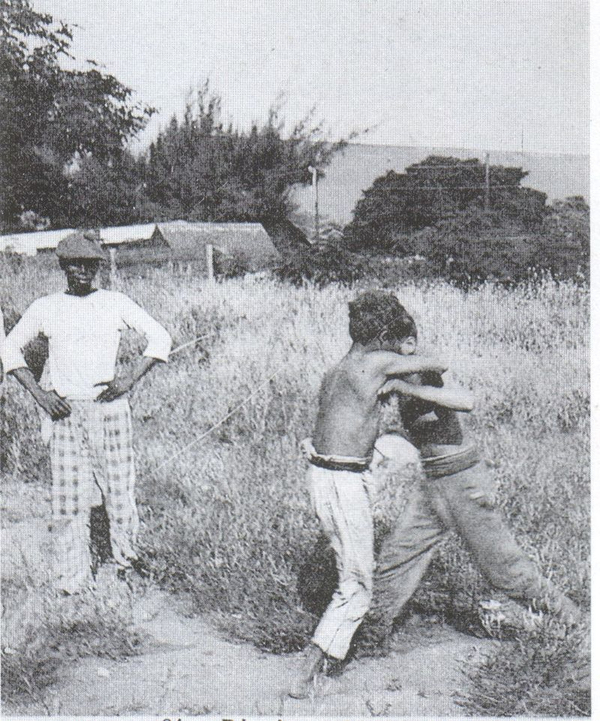
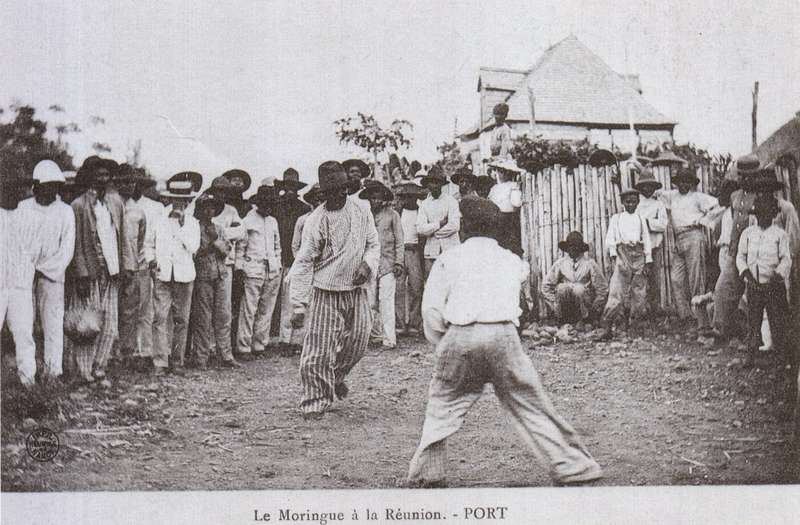
- Description:
In La Croche, the fight does not end when one of the two opponents falls to the ground. Competitors will continue until either of them succumbs, hitting the ground if unable to speak, or shouting "Stop!" "Or" Peace! ". Hence the motto of the sport: "I fight for peace!"
Grips, strangulation, various immobilization are used, without grabbing clothes. The recommended outfit is simple.
- Current status:
The discipline which had disappeared in the course of the 1970s, totally submerged by sports from outside, is again practiced in several clubs of Saint-Paul but also in other municipalities of Reunion Island and Mauritius. . Its practitioners range from very young children (from 5-6 years old) to adults.
Le Comité Régional de Lutte de la Réunion (The Regional Wrestling Committee of Réunion) recognized the croche as a “traditional wrestling” in 2005.
Thanks to the book La croche - Reunion traditional wrestling published by Azalées editions in 2006, the discipline was then presented (and applauded) during the general assembly of la Fédération Française de Lutte (the French Wrestling Federation) in 2006.
As this book is also prefaced by Raphaël Martinetti, president of FILA, la Fédération Internationale des Luttes Associées, which supports the dissemination of Olympic wrestling on the basis of traditional wrestling, “la croche” has also acquired the official status of “traditional wrestling. ”Among the 250 or so listed by FILA.
In October 2009, “la croche” was presented to the University of Reunion during a conference as part of the Creole Day. The opportunity to introduce this game “for a long time” to today's students.
In January 2012, the croche reached a first international dimension by bringing together competitors from four different islands of the Indian Ocean: Réunion, Mauritius, Rodrigues and Madagascar.
In May 2014, a Confederation of the Indian Ocean of Croche was founded in Mauritius, following the 2nd edition of the Indian Ocean Championships of Croche. This Confederation brings together several national federations and regional leagues, having participated in this competition, in the presence of the Minister of Youth and Sports Satyaprakash Ritoo and of the President of the Mauritius Olympic Committee Philippe Hao Thyn Voon.
In October 2014, after some executives of the Regional Wrestling Committee of Reunion tried to modify the regulations of the crooked croche to "fight", the crooked clubs take their independence and found the Ligue de Croche. Crochet is now a sport in its own right and not just a discipline among other struggles, Olympic or not. And in 2015, the Croche League was admitted to CROS-Réunion as an "identity sport".
As of the 2015/16 season, the sport "la croche" is available in two styles: without striking (which represented the majority of traditional practitioners) and with striking (2nd style nicknamed in Creole: the "eighth note" or "kros batay ", according to the etymological or phonetic spelling).Source: https://fr.wikipedia.org/wiki/Croche_(sport_de_combat)
- Contacts:
La croche, lutte traditionnelle de la Réunion
Web: http://lacroche.re/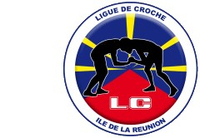
La Croche St Joseph
Email:This email address is being protected from spambots. You need JavaScript enabled to view it.
Tel. +262 692 42 38 17
Fb: https://www.facebook.com/LaCrocheStJo/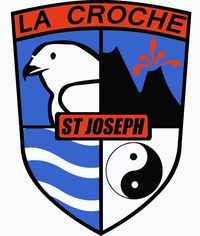
- Sources of information :
Book:
Patrick Blanca, Frédéric Rubio et Jérôme Sanchez, La croche : lutte traditionnelle réunionnaise, Éditions Azalées, 2006Articles:
https://www.sportetville.org/la-croche-lutte-traditionnelle-de-la-reunion/Video:
https://www.youtube.com/watch?v=9QuRsTtYxzg
https://www.youtube.com/watch?v=y_Q52ZEQOUMSource of photos used in this article and gallery:
http://4.bp.blogspot.com/-EE1njauzpoY/VInXDMbxUpI/AAAAAAAAINw/qnUVvjYuUt0/s1600/Cl.%2BAngelin.%2BCPA%2Bcoll.%2Bpriv%C3%A9e%2Bsd..jpg
http://www.lacroche.re/plugins/diaporama/diaporama.php?lng=fr&diapo_id=1
https://fr.wikipedia.org/wiki/Croche_(sport_de_combat)
https://www.ipreunion.com/sports/reportage/2019/03/06/les-avirons-lutte-une-journee-pour-les-jeunes,98722.html
https://www.journal.re/sport/championnat-de-la-reunion-de-croche-ce-dimanche-a-saint-joseph.html - Gallery:
- Documents:
 Codification_de_la_croche_a_partir_de_2014_2015.pdf
Codification_de_la_croche_a_partir_de_2014_2015.pdf Historique_des_combats_de_croche_format_portrait_pour_impression.doc
Historique_des_combats_de_croche_format_portrait_pour_impression.doc
- Name of sport (game): Dambe
- Place of practice (continent, state, nation):
NIgeria, NIger, Chad
- Sources of information :
Book:
Edward Llewellyn Powe, Combat games of Northern Nigeria, D. Aiki Publications, 1994, 126 p.Articles:
https://theculturetrip.com/africa/nigeria/articles/a-look-into-nigerias-brutal-boxing-art-of-dambe/
https://www.aljazeera.com/indepth/features/dambe-ancient-form-nigerian-boxing-swept-internet-180608112430973.html
https://www.bbc.com/sport/football/52185587Video:
https://www.youtube.com/watch?v=wALTzh2CFV8
https://www.youtube.com/watch?v=X_4SisZT1bU
https://www.youtube.com/watch?v=BvLA2xcr0z8 - Gallery:
- Name of sport (game): Dibeke
- Name in native language: Dibeke, also called Nikkies, Skaloulo and Kimberley Jim
- Place of practice (continent, state, nation):
South Africa
- History:
According to oral history the name Dibeke came after the game was already played, to describe the addictive nature of the sport to the youth, which played week-in week-out every day of the week.
- Description:
Dibeke (also called Nikkies, Skaloulo and Kimberley Jim) is a multi-running ball game played with two teams of 12 players. The teams take turns to attack and defend. Individual attackers are called and must kick the ball beyond the centre lines towards the attackers’ box.
Rules of Dibeke
The game is played on a field that is 60 metres long and 40 metres wide. The main playing area is a strip, similar to a cricket pitch, where the attackers score their points. The defenders are scattered around this strip. The manner in which you accrue points is similar to baseball and cricket, in that you are out if the defenders tag you with the ball.
Instead of a bat, as in cricket or baseball, the dibeke attackers kick the ball (a soccer ball) and defenders can use their hands to pass the ball to each other in an effort to tag the attackers. Once the ball is in play, the game is basically a challenge for the opposition to score as many points, up and down the strip, as possible. Once all the attackers are out, the defenders then get their turn to attack.
There is a time limit, though, with two halves of 40 minutes. If the attacking team is not dismissed, the remaining players can carry on attacking for the duration of the match, to be declared the winners.
Each team consists of 12 players, six girls and six boys.Equipment
– One size 3 leather ball for seniors.
– One size 1 leather ball for juniors.
– Two stopwatches.
– Two scoreboards with numbers 1 to 20 shown on each of them.
– A score-sheet to record points and the final score.
– A 30-metre measuring tape.
– Lime to mark the playing field with.
– A whistle for the match facilitator.
– One red card and one yellow card.
– Two hand flags for linespersons.
– Each player should have their letters clearly printed on the front of their shirt.The play area
The pitch is an open grassy area of approximately 60m long and 40m wide. The borders are marked with a white line. An area of 10m around the borders should be left open as an extended play area.
The white centre line divides the length of the pitch into two equal rectangles of 40m x 30m. The centre circle has a radius of 1.5m. It is marked with a white line and is divided into two equal semi-circles by a centre line.
There are two attackers’ boxes (10m x 5m). Each team chooses a ‘home’ box. The box stretches from the back line towards the centre line; its side borders are 15m from the side borders of the area of play. The attackers’ boxes are shown by white lines at both ends of the playing area.
The kicker’s box is a rectangle of 1.5m x 5m, stretching towards the centre line. The rolling area is between the kicker’s box and centre circle. The side borders are marked with a broken white line.
The defenders’ area, in which the defending team is spread out, is behind the median (midline). The players stand behind the roller of the ball (from the defending team) who takes up his or her position in the centre circle (roller’s box). The attackers are positioned in a straight line. One attacking player is called to enter the kicker’s box. He or she kicks the ball from the kicker’s box across the median line in the defenders’ area.Team composition and roles
There are two teams of 12 players per team, made up of 6 males and 6 females. A full squad for competitions should consist of 12 players for each team of equal gender representation.
Each team chooses a captain. The captains of both teams liaise with the match facilitator during the match. Each team nominates a scorekeeper. The two scorekeepers count the runs of each player and of the team during the match.Each team has an opportunity to be ‘attackers’ or ‘defenders’.One of the defenders acts as the ‘roller’ of the ball. He or she will roll the ball and call out the letters of an attacker (shown on the jersey of the player), one of whom will be called to enter the ‘kicker’s box’ and kick the ball into play. This player is then known as the ‘kicker’.Game description
The captains toss a coin to decide who will be the defenders and who the attackers. The match facilitator blows the whistle twice for the attackers, the roller and the defenders to take up their respective positions on the pitch. This occurs at the start of the match, the start of each round, and every time play is resumed after the half-time break or an interruption (i.e. when the ball has gone ‘dead’).
At the start or re-start of play, the attackers stand next to each other in a single line in the attackers’ box. The defenders position themselves in the defenders’ area (on the centre half of the pitch opposite the attackers’ half of the pitch). No defender may stand outside the pitch before the ball has been kicked.
The roller takes up position in the roller’s semi-circle in the middle of the field. When the match facilitator starts the game, the roller calls out the letter of an attacker (shown on the jersey of the player) and rolls the ball along the ground towards the attackers’ area. The ball must remain on the ground and within the roller’s area until it is kicked by the attacker. The ball is rolled under-arm. The speed of the ball is of no consequence.
The attacker whose letter was called immediately steps into the kicker’s box and kicks the ball beyond the centre line. After kicking the ball, he or she must run to the attackers’ box on the opposite end of the pitch. The kicker’s team-mates may ‘help’ the kicker by running with him or her to the attackers’ box on the opposite side of the pitch.
The defenders try to catch the ball or retrieve it as soon as possible. After retrieving the ball, the defenders ‘eliminate’ the players of the attacking team by throwing the ball at them – trying to hit them with the ball. If an attacker is hit, then he or she is ‘out’ for the rest of that round.
If the attackers arrive safely at the other end (in the attackers’ box), then they are safe to continue to play until they are all out and the teams change around (attackers become defenders and vice versa). The attackers cannot be hit while they are in the attackers’ box or in their home box.Rules
If a defender calls an incorrect ball (a letter of an attacker which is not correct), then we call this a dead ball. A dead ball can be brought back to the field of play by any player from either side.
Technical officials will review the team’s performance at the end of each day.
If an attacker with one foot inside the box is hit, then that attacker is out. He or she is only safe with both feet inside the box.
If a ball is caught midair by a defender, while members of the attacking team are still running to their box, then all of the players who are out of the box are caught out. Only those who are home are safe.
There are two linespersons on the pitch. These linespersons use flags and ensure that no players run off the field of play during the game.
Code of Conduct
Abusive language may not be used on the pitch.
Fighting is not allowed.
A player will be sent off for threatening or fighting with officials or other players.
A team will be disqualified if they miss a match.Scoring
The attacking team scores when:
– an attacker reaches the opposite attacking box safely. This counts as 1 run.
– an attacking team member makes 20 runs. The attacking team is awarded 2 points and the eliminated attackers are set free – to join the others in the home box to start play as attackers in the following round.The defenders score when:
– all the players of the attacking team have been eliminated. In this case, the defending team scores 1 point. When all the attackers are out, the teams change around and the attackers become defenders, taking up position in the attackers’ box, while the defenders position themselves in the defenders’ area.
A run is scored each time an attacker has run from one attacker’s box to the other one without being hit by the ball. Runs can be scored at any time while the ball is in play.
A short run is made when an attacker does not run the full length of the field. In this case, the match official will call one short run, indicating the letter of the attacker as soon as the ball is dead (any runs attempted or previously scored by the attacker, except for the last one, are cancelled).A win
The team with the highest score at the end of the allotted playing time wins the match. Attacker(s) are eliminated (out) until the next round when a player / attacker:
– whose letter has been called fails to kick the ball beyond the centre line in the field of play.
– is hit by a defender’s ball when he or she is outside any of the attackers’ boxes after the ball has been kicked into play.
– who was previously dismissed is hit during his / her run back to the attackers’ box after a round has been completed.
– runs outside the boundaries of the pitch at any stage of the play.
– kicks short of the defenders’ area or misses the ball for the third consecutive attempt – only two misses are allowed.The whole attacking team is eliminated (out) when:
– the ball of the kicker is caught in mid-air (caught out).
– all the attackers have been hit (one at a time) while they are outside either of the boxes.Substitution
A team is allowed an unlimited but regulated number of substitutes during a match.
No more than three substitutes will be allowed on the pitch at the same time during play.
Substituting a player may not take place within three minutes of the last one.
The match facilitator and scorekeepers will record all substitutions.Fouls/Penalties
A player will receive a red card and be suspended for the duration of the game if he or she:
– incites other players or supporters to disrupt the game.
– assaults or insults another player’s match official or supporter.
– displays a negative gender attitude towards a player of the opposite sex.A player will receive a yellow card (warning) and be suspended for the round of the game in which the offence was committed if he or she:
– obstructs another player during play.
– challenges the authority of a match official (this does not apply to the captain, who may query a decision).
– delays throwing the ball while an attacker is running, or gives the attacker a chance to dodge a possible hit with the ball.The following general fouls will also be penalised:
– Any player of the attacking team who makes a short run will forfeit all runs he or she has accumulated, except for the last run.
– Any roller will be replaced when he or she rolls the ball outside the rolling area or in the air for the third consecutive attempt.Duration
An official game is 80 minutes divided into two equal halves of 40 minutes each, with a half-time break of no more than 10 minutes. However, if informally played, the players may decide beforehand how long they want to play for, as long as both teams agree and are treated fairly concerning the duration and rest periods of the game. - Current status:
Practiced
- Sources of information :
Video:
https://www.youtube.com/watch?v=2kds_tnzOfI
Source of photos used in this article and gallery:
https://www.jsltv.co.za/article/dibeke
- Name of sport (game): Donga
- Place of practice (continent, state, nation):
Omo Valley of Ethiopia (Suri tribe)
- Description:
One of the main Surma / Suri customs is stick fighting. This ritual and sport is called Donga or Sagenai (Saginay). Donga is both the name of the sport and the stick, whereas sagenai is the name of the stick-fighting session. Stick fighting is central in Suri culture. In most cases, stick fighting is a way for warriors to find girlfriends, it can also be a way to settle conflicts. On this occasion men show their courage, their virility and their resistance to pain, to the young women. The fights are held between Suri villages, and begin with 20 to 30 people on each side, and can end up with hundreds of warriors involved. Suri are famous for stick fighting, but they are not the only ones to respect such a custom, as the neighbor tribe, the Mursi, also practice these traditional fights. The day before the sagenai, fighters have to purge themselves. They do it by drinking a special preparation, called dokai, which is made of the bark of a special tree, which is mixed with water. After taking it, warriors make themselves vomiting the drink. The water is supposed to bring with it many of the body’s impurities. After this ritual they don’t eat until the following morning. Warriors walk kilometers to come fighting at Sagenai, which takes place in a clearing. They stop when crossing a river in order to wash themselves, before decorating their bodies for the fight. They decorate themselves by sliding the fingers full of clay on the warrior’s bodies. This dressing up and decoration is meant to show their beauty and virility and thus catch the women’s attention. The phallic shape ending the sticks contributes to that virile demonstration. Fighters arrive on the Donga field all together, carrying the strongest man,dancing and singing. Some fighters wear colourful headdresses sometimes with feathers on it, and also knee-protectors. But most of them use no protection at all and fight completely naked in order to show their bravery. They also wear strings of decorative coloured beads around their necks given by the girls and waist, but their genitals are most of the time uncovered and they are barefoot. All of them get a chance to fight one on one, against someone from the other side. In the beginning each fighter looks for an opponent of the same stature, and exchanges a few held back blows with him in order to test him. If both fighters feel they have found a match, they suddendly throw themselves into the fight, hitting ferocious fast strokes with their sticks. If one of the warriors knocked out or puts paid to his opponent, he immediately declares himself the winner. Sagenai consists in qualifying rounds, each winner fighting the winner of a previous fight, until two finalists are left. It is strictly forbidden to hit a man when he is down on the ground. During these fights there are referees present to make sure all rules are being followed. Many stick fights end within the first couple of hits. Nevertheless the fights are really violent, and it is quite usual to see men bleeding. Stick fighting has proven to be dangerous because people have died from being hit in the stomach. Loosing an eye or a leg during the fight is quite common, although it is strictly forbidden for a fighter to kill his opponent, and if a fighter gets killed during the fight, his opponent and all his family are banned from the village for life. For the other locals, especially teenagers, sagenai is a great outing. Girls watch the fights, but it is also the occasion to check out the men, and to meet in order to chat or even gossip. At the end of the fights, the winners point their phallic sticks in direction of the girls they want to date with, if the girl put a necklace around the stick, it means she is willing to date the champion.
Source: https://pl.pinterest.com/pin/313492824036632565/ - Importance (for practitioners, communities etc.):
The Suri is a proud people who live in the southwest of Ethiopia, far away from and unaffected by modern, contemporary civilisation. They honor centuries-old traditions, such as the annual Donga. During the annual traditional stick fights, also called the Donga, the naturally peace-loving Suri men show a very competitive side to gain prestige within the tribe. The aim is for young men to duel with stick fights in order to show their strength and masculinity and to gain respect from their family and the community. And of course they conquer the hearts of young girls before marriage. The groups sometimes consist of hundreds of men, coming from different villages. They use their best warriors and approach the battlefield in a large clearing. They do this while singing and try to impress their opponents.
The duel winners continue to fight each other until one last victor remains. Losers are expected to accept their defeat gracefully and withdraw from the field. The last victor is carried on a platform with poles and taken to a group of unmarried young girls, one of whom will choose him as her future husband.
Source (text Henk Bothof): https://pureofftheroad.com/donga-traditional-stick-fighting-of-the-suri-people/?lang=en - Sources of information :
Articles:
https://goingawesomeplaces.com/mursi-tribe-donga-stick-fighting-tournament-brutal-unexpected/
https://pureofftheroad.com/donga-traditional-stick-fighting-of-the-suri-people/?lang=en
https://detayphoto.com/ethiopia-stick-fighting-saguinePhotos:
https://www.flickr.com/photos/mytripsmypics/albums/72157628274797523/Video:
https://www.youtube.com/watch?v=_jmN5RiEBVs
https://www.youtube.com/watch?v=TxmQ4MUewKc
https://www.youtube.com/watch?v=33xJxRN5gHQSource of photos used in this article and gallery:
https://detayphoto.com/ethiopia-stick-fighting-saguine
https://pureofftheroad.com/donga-traditional-stick-fighting-of-the-suri-people/?lang=en
https://pl.pinterest.com/pin/313492824036632565/
https://www.thesun.ie/news/896855/ethiopian-fighters-are-pictured-drinking-raw-cow-blood-for-strength-as-they-prepare-for-the-suri-tribes-ferocious-stick-fighting-festival/
https://goingawesomeplaces.com/mursi-tribe-donga-stick-fighting-tournament-brutal-unexpected/ - Gallery:
- Name of sport (game): Dula Meketa
- Place of practice (continent, state, nation):
Etiopia
- Description:
Dula Meketa is an Ethiopian combat sport practiced by the Oromos which uses combat sticks.
- Name of sport (game): El Matrag
- Name in native language: El Matrag
- Place of practice (continent, state, nation):
Algeria
- History:
It is difficult to accurately trace the history of this sport, but it is certain that its cradle is the Oran province, that is, the northwest region of Algeria, and it appeared more than two centuries ago. According to some sources, the shepherds of this region have defended themselves in this way against herds thieves. However, it seems that this sport originally has roots in war because the moves are very similar to saber techniques. Even if we can only speculate, with the lack of tangible sources on this topic, we can imagine that the Berber Arabs have practiced the fight for sticks from ancient times because there are several reasons in the history of these people with long series of constant conflicts with different intensity. Therefore, the values and traditions of warriors were at the center of men's lives which logically resulted in continuous training of the warriors and rivalry preparing for real fights. In addition, it seemed more logical to use olive tree sticks to train sabers fight that were easily available. A different situation was with sabers that had to be kept. Moreover, the length and weight of these sticks were similar to sabers, we know, for example, that the Berber warriors of Kabila have been using Flyssa since the 18th century, which is a sword that can be long up to one meter. Studies show that one of Berberian large sabers can reach up to 1m 15cm, i.e. the size of Matragas. In addition, Berbers from the times of Emir Abdelkader used a slightly curved long sword of Turkish origin, less than one meter long called "yatagan" in battle.
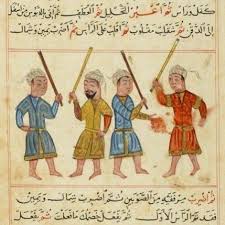
The unreliable information about the origin of Matrag reaches back to the genesis of its practice, as we know it today, exactly in the time of Emir Abdelkader, that is, at a time when a large proportion of Algerians are armed with resistance against the French invasion that began in 1830. It seems obvious that this state of intense and almost continuant war which lasted over fifteen years (from 1830–1847), favoured and developed even more belligerent practices in the Arab-Berber tribes of the Algerian West, which as it should be remembered, was the main area of the Muslim struggle against the French occupier. Therefore, it is probably no accident that the Matrag art has been particularly developed in this region to this day. Moreover, there is a direct relationship between the Matrag and Kader's resistance to the French. The style of this struggle was finally shaped and codified. However, it contains a strong symbolic element because to this day the Matrag in some way embodies the spirit of fight and insubordination of Algerians against the enemy and injustice.
It is worth to remember that the great masters ("sheikhs") of Matrag often refer to a verse from the Koran that refers to this practice, this gives Matrag the deep Arab-Muslim identity of this martial art: "He (Moses) says:" This is my stick on which I withstand, which I use to tear off (trees) for my sheep and use it for other purposes” (Koran 20/18). This is a fragment of the Koran in which Moses is in the holy valley of Tuva, where Allah addressed him directly, saying: "And what is in your right hand, Moses?" He says: "This is my stick on which I withstand, which I tear off (trees) for my sheep and use it for other purposes." [Allah] said to him, "Drop it, Moses." He dropped it and there was a slithering snake. [Allah] says: "Grab him and do not be afraid of anything: we will restore him to his first state" (Koran 20 / 17-21). So the Matrag masters see in the sentence "[...} and I use it for other purposes" that there is a reference to stick fighting. Perhaps this is why some say without evidence that a practicing Matrag can become a champion only after facing the snake with a cane, as part of a kind of initiation and secret ritual
This practice was passed and practiced discreetly during the colonial period. The French authorities were reluctant to look at this martial art that connected the "natives" with the deeply rooted culture that the occupier wanted to wipe. Spirit of a fight among them but mainly prepared them specifically for armed combat. It would seem that the Matrag was not so clearly visible during the days of the first leaders of independent Algeria. In the early 1980s, this art came out of some sort of oblivion, since it was actually practiced far away from human clusters, especially in forests. It should be noted that some old Matrag masters still have a concern to pass on their knowledge in a discreet manner to their "guendouz" (the student chosen to receive the entire master's knowledge) or their students in general. Nevertheless, in Algeria, there are many Matrag clubs with their headquarters in cities.
- Description:
The word "Matrag" is a term in the Algerian dialect from the classical Arabic "mitraq", which means "hammer" and which in French gave it the sound "matraque". The Matrag defines both the Algerian martial art and the weapon used to practice it which art is also often referred to the "Algerian Cane". Indeed this is a kind of simple cane made from a wild olive tree or oleaster which in Algeria is called "zeboudj". Is a tree comes from North Africa, where it grows in its natural state but also occurs in other countries around the Mediterranean Sea, grows in forests, maquis or in valleys. The quality of this wood is unique, it combines two basic features of weapons: flexibility and solidity. Those who practice this art know how difficult it is to break a stick made of this tree. In addition, the Zebudj stick is relatively heavy and thickset, probably due to the high concentration of juice.
It should be noted in this connection that those who prepare battle sticks cut them at a certain time of the year when their juice concentration is optimal. The size of the Matrag is about two cubits, i.e. about 1m15; when it comes to thickness, it is variable, a thin cane allows faster handling, while a thicker cane is certainly heavier but even more dangerous. Let’s say that the average diameter varies between 1 and 2 cm. Flexibility, density and solidity make Matrag a very effective weapon, comparing it with a saber is not an exaggeration, besides practicing this sport, people who know the damage that can be caused by this stick often make such a comparison.
The hits are strictly codified and there are fourteen, all the "edge" of the stick, pushing hits which are much more dangerous are formally prohibited, except in situations of self-defence, for example before a person armed with a knife. So we have two strokes (inside / outside) in the ears (a tarch, literally "stun"), two in the chin (lihya, "chin" in Arabic), two in the forehead (ra`s), two in the ribs (janb) , two in the lower part of leg (rijl), two in the arms (katf) and two in the elbows (mirfaq). These fourteen strokes, combinations were made up of several strokes given in a strictly defined order which combinations are known and practiced by everyone. So, for example, all Matrag practitioners start a fight after they greet each other respectfully by tapping the cane at their opponent, making an initial and obligatory combination called "wajbat", which consists of four moves, one for each ear, one for a chin and one on the forehead.
The course of competition is quite simple, the attacker makes a series of strokes, the defender deflects them in accordance with established techniques and then, in turn, performs the same series to the opponent. The goal is to combine short hisâbs, which can lead to the continuous repetition of a series of fifteen or twenty movements. This training requires a lot of work and concentration because players must repeat this type of series. The goal after learning the gestures, combinations and sequences of hits is to get used to unpredictable strokes. In this way, at a higher level practitioners do competitions, they use many variants or introduce unforeseen hits into their scheme to hit the opponent, who deflects the hits Sometimes the opponents must be very fast and strong, he must show great efficiency to counteract these unexpected hits. These strokes are usually exchanged in continuous forward and backward movement as well as circular movements.
Duels between masters or experienced practitioners naturally resemble fights in Asian styles such as Arnis (Philippines), Kung Fu (China) or Aikijo which is a Japanese martial art whose weapon is a stick with a length of 1m20 and the techniques are very similar to Matrag. It should also be noted that the current great Matrag masters are often experts in Asian martial arts (judo, aikido, karate Shotokan etc. Matrag practitioners are mutually respectful, humble and honest people. Brotherhood and honor are their cardinal value.
There are 4 elementary moves used in the matrag:
The tarcha dakhlaniya which consists of the interior strike;
The tarcha barrania which consists of the external strike;
The lahiya which consists of the lower strike;
The flush which consists of the upper strike. - Current status:
The Matrag is practiced in public during Wadas, which are large solemn meetings in the open air, something similar to a market. There you can hear bards proclaiming ancient Bedouin poems, eat couscous sitting cross-legged under tents but above all the old tradition of la'b al-bârûd, which has at least two centuries of existence is consolidated. It's about the rivalry of riders, during which they drive at high speed perform acrobatic exercises loading and unloading the rifle as well as shooting at full gallop and simultaneously by the "team". This rivalry and Matrag are therefore associated as two essential aspects of warrior culture and Algerian practice which confirms the ancient martial origin of the stick martial art.
- Importance (for practitioners, communities etc.):
For Algerians, it seems that Matrag is a real living treasure of their cultural heritage that deserves to be developed and disseminated. This art that has positive values is worth rediscovering, practicing and passing on to future generations because it is part of a wonderful civilization and the intangible cultural heritage of Algeria.
- Contacts:
Fédération Algeriènne Des Jeux et Sports traditionnels
Rue 05 juillet bargua Bechar, 08002 Béchar
Tel: 0021349215917
Fb: https://www.facebook.com/F%C3%A9d%C3%A9ration-Algeri%C3%A8nne-Des-Jeux-et-Sports-traditionnels-168128913541039/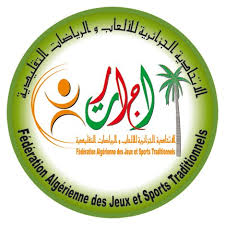
Federation Française Matrag
Tel: 0609694679
Fb: https://www.facebook.com/ffdmatrag/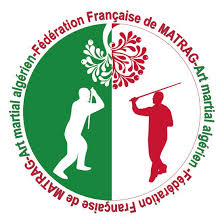
- Sources of information :
Video:
https://www.youtube.com/watch?v=SqFmjFJVfcA
https://www.youtube.com/watch?v=KFjmhGt9Tks
https://www.youtube.com/watch?v=X21Nj-oaNl4
https://www.youtube.com/watch?v=thWeuHXRJzcSource of photos in this article:
https://pl.pinterest.com/pin/596304806901888933/; https://nessahra.net/el-matrag-la-maabza-la-fantasiadecouvrez-les-anciens-sports-de-combat-encore-pratiques-en-algerie/; https://fr.shafaqna.com/le-matrag-un-art-martial-musulman/; - Gallery:
- Name of sport (game): Engolo or Ngolo (n'golo)
- Place of practice (continent, state, nation):
Various ethnic groups around the Cunene River in southern Angola
- History:
Engolo or NGolo is a performance of ritual combat by various ethnic groups around the Cunene River in southern Angola. The style of fighting involves various kicks, dodges, and leg sweeps, with an emphasis on inverted positions, i.e. with one or more hands on the ground. The first mention of Engolo in literature was made by Albano Neves e Sousa in a set of drawings demonstrating various techniques and their similarities to the Afro-Brazilian art form of Capoeira in the 1960s. Engolo is one of several African martial arts of the African Diaspora in the Americas.
Neves e Sousa described Engolo as part of a rite of passage, Omuhelo, between young boys vying for a bride in the contest, and whose techniques derived from the peculiar way in which Zebras fight amongst themselves. Research carried out by Dr. TJ Desch Obi finds that Engolo itself is not strictly performed for any one ritual, but as an element in various public and private performances.
In his book Fighting for Honor, as well as his article "Combat and Crossing of the Kalunga", Desch Obi draws parallels between the circle space used in the Engolo and the inverted techniques with the Kalunga cosmology, in which the spirit–ancestor world is inverted as a world of opposites: where men walk on their feet, the spirits walk on their hands, where men are black, the spirits are white, where men reach their peak physical abilities in life, the ancestors reach their peak spirituality. He states that men in performing Engolo with its inverted positions connect themselves physically and spiritually with the ancestors, and with specific ancestral warriors of the past.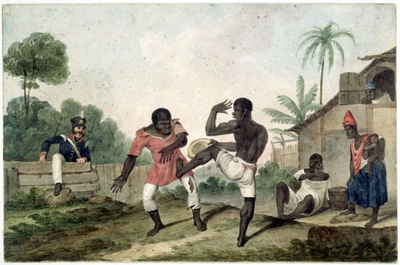
Apparently, it was in 1960 that the presence of this form of martial art was first acknowledged via a discovery of a set of drawings. Furthermore, these drawings basically illustrated the technique used in Engolo which closely resembled the Afro-Brazilian form of combat known as “Capoeira”. In addition, this form of combat is said to be a part of a ritual known as “Omhelo”. It is in this ritual that young men compete with each other in order to find a bride to marry. It is also said that the fight technique used by these young men in this ritual is similar to the way a group of Zebras fight amongst each other.
- Description:
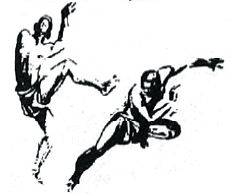
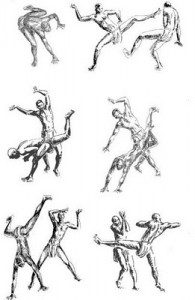
- Sources of information :
Articles:
https://berimbrasil.com.br/ngolo-ou-danca-da-zebra.html
http://capoeiraflagstaff.org/history-of-capoeira-angola
- Name of sport (game): Evala
- Place of practice (continent, state, nation):
Togo
Initially practiced in the nine Kabyè districts, the evala wrestling has crossed the borders of the Kozah province. The Yaka district in the Doufelgou province also practices it now, not to mention at least 13 other districts — Lama, Pya, Tchitchao, Yadè, Bohou, Kouméa, Sarakawa, Landa, Djamdè, Yaka, Tcharè, Soumdina and Lassa.
- History:
The most important initiation ritual in the Kabyè society is played by the Evala, a ritual fight, a kind of wrestling, that marks the passage of young males to the stage of maturity.
In the past, the fights, that could last for several hours, were practiced using a chicotte, that is a kind of riding crop and a stick, with these two objects the adversaries would face each other hitting each other until one of them failed , exhausted by the blows received.
When he fell, the alleged winner rushed over him and sat on his chest, only at that moment the referee declared the end of the game and its winner.
This system of fight matches began to resolve inter-tribal conflicts, so the fight replaced the war between tribes; today, however, the organization of ritual fights also has a more festive aspect and, at each celebration, a magnificent spectacle is created.
The Evala is an initiation rite, the penultimate of rites in the life of a man, it is certainly the most important and, to prepare for this event, young people are separated from their families for a week, living in special huts, where they are fed and are mentally prepared.
Young people also face a preparation that involves numerous sacrifices that the adolescent must accept: fasting, sexual abstinence and scarification. - Description:
Before starting wrestling, participants must make a pilgrimage, that consists of climbing three mountains; those who do not complete the pilgrimage will be initiated into adulthood.
Before the match each competing family performs some ancestral worship rituals, invoke the spirits of the ancestors who dwell in the clay statues placed in the courtyard of the housing complexes, each statue represents an ancestor.
The elder of the family speaks with the clay statues as if he was talking to a member of the living family, invokes the ancestors who live in the clay, and pours a libation as an offering.
The sacrifice is part of the ceremony and the numerous feathers that cover the clay statues are the result of these repeated acts of worship.
For large events such as the Evala, the clay statues are carefully and respectfully removed from their niches to be worshiped; if a white rooster flaps its wings, people believe it is a benevolent sign of the ancestors.
The women prepare a local dish, based on yam and manioc, that will be served to the wrestlers after the match.
There are offers of libations to the ancestors, together with a bowl of corn wine, so that they can help and protect the family, this is a very solemn moment of the entire ceremony.
At this point the actual ceremony can begin, the main purpose of this ritual is to make the young man hard, brave and stoic and consecrate not only the transition from adolescence to adulthood, but also the affirmation of his Kabyè cultural identity.
The consumption of dog meat is a central and essential element of the Evala ritual, for the aspiring Evalou, this consumption is not a choice but rather a prescription necessary for the fulfillment of the initiation rites, the initiate is forced to consume dog meat to acquire the qualities of this animal: resistance, tenacity, strength and intelligence.
A teenager has to fight for three consecutive years, starting from the age of 18, before he can be considered a man, the fights involve two teams composed of 4 or 5 wrestlers who face bare-chested, under the eyes of their parents, friends and onlookers who encourage them with songs, shouts and sounds of horns.
The wrestlers are sprinkled with white powder, a symbol of value, and fight until sunset, giving their best, whether or not he wins, the tribe recognizes the initiate as a man, a young man who has never fought is not considered an adult, especially not among his peers.
After several stages of confrontation between the teams, the winners can be proclaimed according to the number of victories, the presence of wise men of the community ensures respect for the rules, and the arbitration of the fights, also reveals the strong traditional aspect of the ceremony.
Successful wrestlers are invited to the chief's house to wear their red berets; men with red berets are called "warriors", ie the best of all fighters.
The Red Cap dance is considered a symbol of maturity and courage in the men's initiation ceremony.
At the end of the Evala, the traditional priests and the feticheur make a tour of the sacred places, above all the sanctuaries that are found in the forests and in the caves, to thank the ancestors for allowing a good performance of the initiation rites.
At the end of the Evala rites, the young man takes a new social status with rights but also obligations including: the right to exploit the land on his own, to marry, to defend the village in case of aggression.
The Kondona, are ceremonies that begin the day after the closing of the Evala, the young initiate, who has completed his three years of fight, becomes an Ezoukpo, a sort of middle class and can aspire to become a Kondo or adult. - Current status:
Practiced
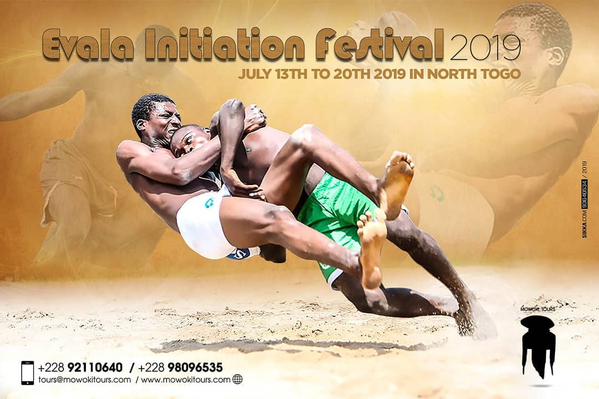
- Importance (for practitioners, communities etc.):
Evala is the very first introduction to the human life of the teenager Kabiye. Before being subjected to these rites, young people have long been prepared psychologically and physically. In Kabyè country, a young person who shies away from this initiation suffers reprisals from the wise men, his parents and the whole of society. He's sort of excluded from the community.
The primary purpose of this operation is to accustom the young person to endurance, courage and stoicism. The cultural aspect of the event is heightened by the sacrifices that the teenager must make: fasting, sexual abstinence and the scarifications which are the outward signs of the warrior.
The traditional aspect of the ceremony is revealed by the presence of the elders of the community. It is these wise men who ensure compliance with the rules, ensuring the management and arbitration of tournaments. The dates on which the ceremonies are held are fixed by the consultation of the oracles followed by the authorization granted by the high priest called "Tchodjo". After the struggles, traditional priests tour sacred places to thank the ancestors for allowing the ceremony.
https://touchstamps.com/Stamp/Details/638523/lutte-des-evala - Sources of information :
Articles:
https://www.myafricanmagazine.com/initiation-wrestling-in-togo/
https://www.exploring-africa.com/en/ethnic-groups/kabye/kabye-male-rites-evala-fight-and-kondona
https://togopresse.tg/les-luttes-evala-2023-demarrent-samedi-dans-la-kozah/Video:
https://www.youtube.com/watch?v=gp-Lc60horQ
https://www.youtube.com/watch?v=7qb1e-rf_-U
https://www.youtube.com/watch?v=ovFosTqmKpA
https://www.youtube.com/watch?v=GWNu6lVkUn8The information contained in the article comes from the following sources:
https://www.exploring-africa.com/en/ethnic-groups/kabye/kabye-male-rites-evala-fight-and-kondonaSource of photos used in this article and gallery:
https://www.republicoftogo.com/toutes-les-rubriques/societe/luttes-masquees
https://lavoixdelanation.info/togo-demarrage-de-ledition-2018-luttes-traditionnelles-evala-pays-kabye/
https://lavoixdelanation.info/togo-debut-de-ledition-2019-des-luttes-traditionnelles-en-pays-kabye/
https://twitter.com/republicoftogo/status/1182698071316226049
https://lomeactu.com/evala-5-raisons-fete-traditionnelle/
https://togopresse.tg/les-luttes-evala-2023-demarrent-samedi-dans-la-kozah/
https://www.savoirnews.tg/blog/2022/07/11/evala-2022-poursuite-des-luttes-lundi-dans-la-kozah-la-finale-dans-le-canton-de-tchitchao/
https://lavoixdelanation.info/togo-demarrage-des-luttes-traditionnelles-en-pays-kabye/
https://togoweb.net/togo-le-calendrier-pour-les-evalas-devoile/news/
https://www.koaci.com/article/2023/07/08/togo/culture/togo-debut-des-festivites-de-la-lutte-evala-2023_170688.html
https://lomeactu.com/togo-clap-de-fin-pour-le-tournoi-de-lutte-traditionnelle-evala/
https://icilome.com/2023/07/togo-evala-quelques-cliches-des-empoignades-a-kara/
https://toplist.info/top-list/most-famous-festivals-in-togo-4694.htm
https://news.piaafrica.com/togo-tribune/togo-evala-quelques-cliches-des-empoignades-a-kara/ff1891576d
https://www.exploring-africa.com/en/ethnic-groups/kabye/kabye-male-rites-evala-fight-and-kondona - Gallery:
- Name of sport (game): Fantasia
- Name in native language: In the Maghreb, fantasia is generally called laâb el-baroud («game of powder») or laâb el-kheil (or «horse game»); more local names also exist: tbourida in Morocco
- Place of practice (continent, state, nation):
Algeria, Morocco, Tunisia, Libya, Mali, Niger, and Mauritania
- History:
Fantasia is a traditional exhibition of horsemanship in the Maghreb performed during cultural festivals and for Maghrebi wedding celebrations. It is present in Algeria, Morocco, Tunisia, Libya, Mali, Niger, and Mauritania.
The fantasia is indirectly related to a very old Berber equestrian tradition, to be related to the introduction of the bearded horse, which was particularly used among the Eastern Libyans to tow tanks, from the XIIIth century BC., then, during the following millennium, adapted as a mount by the Paleo-Berbers, with, later, the riders of the famous numid cavalry of King Massinissa.
Reported at the end of the 18th century by the testimonies of travelers in the Maghreb, it will be formally known, and will take the name of fantasia, from 1832, thanks to the French painter Eugène Delacroix and the paintings he makes of it. It then became one of the favorite subjects of the most illustrious Orientalist painters, such as Eugène Fromentin or Marià Fortuny. - Description:
The performance consists of a group of horse riders, all wearing traditional clothes, who charge along a straight path at the same speed so as to form a line, and then at the end of the charge (about two hundred meters) fire into the sky using old muskets or muzzle-loading rifles. The difficulty of the performance is in synchronizing the movement of the horses during acceleration of the charge, and especially in firing the guns simultaneously so that one single shot is heard. The horses were bred from the Arabian and Barb breeds or a mixture of the two.
The fantasia is considered a cultural performance and a kind of martial art; it also symbolizes a strong relationship between the man (or woman) and the horse, as well as an attachment to tradition. It is historically related to the famous Numidian cavalery charge.
Fantasia performances usually take place during local seasonal, cultural or religious festivals, also called moussem ("saint's day festival" in Arabic). - Current status:
Algeria
The Algerian Equestrian Federation is the body responsible for the organization and development of modern and traditional equestrian practice in Algeria, including fantasia. 140 equestrian associations, organized in nine regional leagues (Aurès, Hodna, Oasis, Dahra, Titteri, Sersou, Saoura, Tafna and Sahara) are affiliated.Morocco
Nowadays, the practice of fantasia remains very lively in Morocco and also concerns women. Its organization and development are the responsibility of the Royal Moroccan Federation of Equestrian Sports. Nearly 1,000 troops, called sorbas, with nearly 15,000 horses, were engaged in the exercise of fantasia. In 2008, the Royal Complex of Equestrian Sports and Dar Es-Salam Tbourida was created, a structure dedicated to equestrian practice and including a school of fantasia and workshops for making riders' clothes and making harnesses.
This complex also hosts, every year, the Hassan II Trophy of Traditional Equestrian Arts (tbourida), a national fantasy competition, comprising three categories: senior men, senior women and junior boys. The trophy consists of two events: harda (salvation), assessing the appearance of the teams (clothing of the riders, harnessing of the horses, handling of the weapons), and talqa, assessing the alignment of the riders and the synchronization of the shots of the rifles. - Importance (for practitioners, communities etc.):
Today, fantasia is symbolically present for the holidays and represents the supreme celebration or apotheosis of a great religious event like Eid al-Fitr. The horses are richly harnessed and can participate from the beginning of the festivities, including escorting the bride. The horseman carries the mukhala, the famous black powder rifle.
In Morocco, the practice of fantasia remains very lively. There are now 1,000 sorbas (troops) and 15,000 active horses. - Sources of information :
Video:
https://www.youtube.com/watch?v=avBCtAiwyUg
https://www.youtube.com/watch?v=27PEwSRgvD0
https://www.youtube.com/watch?v=WLk7jfE0N8w
https://www.youtube.com/watch?v=SzRYCPO7-4oPhoto: Guillaume Lanouhe, Brev’Art
- Gallery:
- Name of sport (game): Genna
- Name in native language: ገና (From Amharic – the official language of Ethiopia) means Christmas. Genna was grown and practiced around this holiday (to be more specific around january 7th becouse of use of Julian calendar in Ethiopia), hence the name.
- Place of practice (continent, state, nation):
The game is practiced only in Ethiopia.
- History:
Genna is the oldest game practiced in Ethiopia. It has been practised for centuries, however, the exact history and the time of creation are not known. There are two legends that may indicate that the sport was invented in the first centuries AD.
First legend says that when the news of the birth of Jesus reached the Ethiopian shepherds, they began hitting the ball with their shepherd's crooks in a fit of happiness, and that is how genna and field hockey were created.
However, second legend is slightly different. Its protagonists are the Three Wise Man who, after visiting little Jesus, returned home. During their journey they met a man who denied the fact of birth. Then the monarchs murdered him and began playing genna with his head.
It is noteworthy that in the first centuries games similar to hockey were very popular. People have been playing games such as pelota purépecha (Mexico) or hurling (Ireland). - Description:
Every team has at least 7, but not more than 10 players. One of them is a goalkeeper. Players can be replaced at any time by somebody from up to 5 people waiting on the bench.
The tennis size ball is made of tree roots and decorated so its colors improve its visibility. The stick, on the other hand, is made of eucalyptus branches and rounded at the end. It is slightly longer than the player's shoulder.
Playing field is 300 meters long and 200 meters wide. To get a point, players need to hit the ball to the opponent's goal. At the beginning two players from different teams face each other in the middle of the field, they contact their sticks 3 times and then fight over a ball.
Game is divided into two 30-minute halves, and the winner is the team that scores more goals. There is also a 10-minute break after first 30 minutes. In the event of a tie, there is a 20-minute overtime. - Current status:
Practiced sport.
Matches always take place on the 7th of January; on other days, people just do not play genna. - Sources of information :
Articles:
https://addisfortune.net/addisfortunefeature/ethiopian-christmas-hockey-yegena-chewata-still-alive/
http://allafrica.com/stories/201701090489.html
https://healthandfitnesshistory.com/ancient-sports/ethiopian-genna-field-hockey/
https://en.wikipedia.org/wiki/GenaVideo:
www.youtube.com/watch?v=UOttBUvRcBU
Source of photos used in this article and gallery:
https://colnect.com/en/stamps/stamp/614228-Genna-Ethiopian_traditional_sports-Ethiopia
https://mereja.com/index/376196
https://mythology.stackexchange.com/questions/2139/why-do-ethiopians-play-gena-on-christmas
https://addisfortune.net/addisfortunefeature/ethiopian-christmas-hockey-yegena-chewata-still-alive/
https://pl.pinterest.com/pin/456482112224759099/
https://lalibelatourandtrekking.com/product/ethiopian-timket-tour/
https://jackpottoursethiopia.com/festival-attractions - Gallery:
- Name of sport (game): Gidigbo, Aki or Akin
- Place of practice (continent, state, nation):
Nigeria
- Sources of information :
- Name of sport (game): Grech
- Place of practice (continent, state, nation):
Tunisia
- Sources of information :

